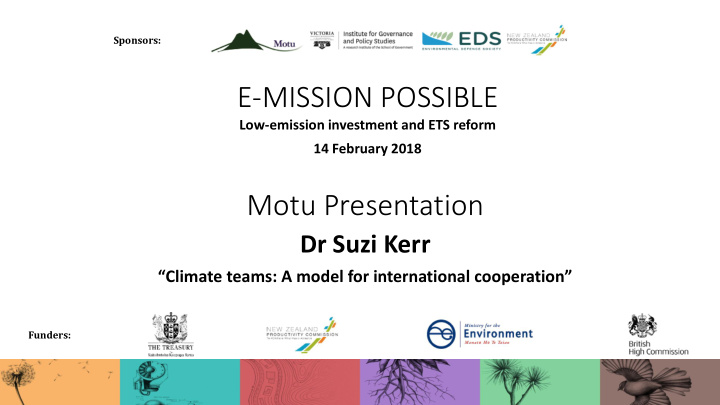



Sponsors: E-MISSION POSSIBLE Low-emission investment and ETS reform 14 February 2018 Motu Presentation Dr Suzi Kerr “Climate teams: A model for international cooperation” Funders:
The problem Globally we need to get to net-zero long-lived gases Mismatch between mitigation opportunities and resources/ commitments to mitigate e.g. Host: Colombia Investors: New Zealand, Republic of Korea… We can help accelerate the transition to low emissions in countries like Colombia.
International emission reductions We need them – and they are part of our contribution to 1. global low emissions transition We can’t buy them from the UN mechanism or through 2. ETS linkage – yet – and may not want to even if we can 3. Government should control the amount of international emission reductions used by NZ; unlimited linkage implies • loss of control of price; and • loss of control over domestic decarbonisation
ETS linking is risky – especially for the small
International emission reductions We need them – and they are part of our contribution to global low emissions 1. transition We can’t buy them from the UN mechanism or through ETS linkage – yet – and may 2. not want to even if we can 3. Government should control the amount of international emission reductions used by NZ; unlimited linkage implies • loss of control of price; and • loss of control over domestic decarbonisation 4. Taxpayers should get the benefit from lower-cost international emission reductions 5. Government may be able to access better quality, lower-cost international emission reductions than other domestic actors 6. Conclusion: Purchasing should be led by government (the only option now), and any future purchase-and-surrender by ETS participants should be limited and not affect total supply
Government-led purchasing options Purchase from UN mechanism (or tender for private actors to purchase from UN mechanism) Purchase from government with strong ETS and overall compliance – but these countries don’t need our help ‘Climate team’ with weaker government and low -cost reduction opportunities
‘Climate Teams’ – working together to accelerate others’ low emission transitions
Layers of global cooperation Paris Agreement: broad but weak Climate club Stronger but focused Climate team: on domestic reductions strong - includes transfers across countries
What ‘hosts’ need (Colombia) 1. Guarantee of income flow if they make large costly (economically or politically) systemic changes energy transition • public transport infrastructure • electrification of vehicles transition of land out of cattle ranching creation and implementation of large scale reforestation programme 2. Expertise 3. Access to capital 4. Co-benefits from contract e.g. poverty reduction, assist peace process, climate adaptation
What ‘investors’ need (New Zealand, Korea…) 1. ‘Internationally transferrable mitigation outcomes’ to meet ambitious international targets during period of domestic transition to low emissions ….and beyond – can continue to contribute to others’ mitigation 2. Credible units in the eyes of domestic taxpayers and voters and in the eyes of other countries – to encourage reciprocal cooperation co-benefits associated with resource transfers – e.g. poverty reduction, assist peace process, climate adaptation
Climate team model BAU CO 2 -e Autonomous contribution by host + climate finance and support Crediting baseline 1. Beyond credible Nationally Determined Contributions 2. Large Scale – additional and no leakage 3. Choose our own team members time
Climate team model BAU CO 2 -e Autonomous contribution by Host + climate finance and support Crediting baseline Additional reductions in anticipation of funding from credit sales Monitored emissions inventory – 4. Low cost monitoring UN rules time
Climate team model BAU CO 2 -e Autonomous contribution by Colombia + climate finance and support Crediting baseline Additional reductions in anticipation of funding from credit sales Monitored emissions 5. Results-based payments inventory – UN rules time
Climate team Agree on a crediting baseline – at least as ambitious as NDC 1. Use ‘climate finance’ strategically to help host country reach NDC 2. Agree on a minimum credit price – to protect the host 3. The investor is required to pay at least this amount Agree on a maximum credit price – to protect the investor against 4. high international prices The host may not sell to others unless the investor agrees 5. Agree on a level of funding committed in advance by the investor Once this is spent on credits, the contract ends 6. Complement contract with aligned finance and expertise Aligns incentives of all with low emissions transition
Risk of lack of supply: seller constrained to sell to team Sellers Colombia Buyers New Canada? Korea Zealand Norway? Australia?
Network of climate teams? Sellers Colombia Vietnam? Thailand? Buyers New Canada? Korea Australia? Japan? Zealand Norway?
Recommend
More recommend